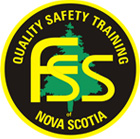Folding Platform & Step Ladders
Hazards Identified
Skips, falls, electrical shock
Hazard-Specific Personal Protective Equipment
None specific to task
Hazard-Specific Training
First Aid/CPR, Awareness training
Safe Work Practice
- Ensure that step ladders are CSA Grade 1 for construction purposes or CSA Grade 1 or 2 for trades purposes. Grade 3 ladders should be immediately discarded. New purchases should be Grade 1.
- Ladders must not be used as a support for scaffolds.
- Before setting up the step ladder, inspect it for missing or loose parts. Repair or replace as necessary. Ensure that the ladder is free of debris and oil. Clean as required.
When setting up the step ladder:
- Keep the ladder away from electrical sources.
- Ensure all four feet are positioned on a firm, level surface. Do not set the ladder up on mobile equipment or on a moving ferry.
- Ensure that the ladder is fully open and the bars are locked.
- While ascending or descending the ladder, face the ladder and use three point contact at all times (one hand and two feet or two hands and one foot).
- Keep your center of gravity between the side rails. Your belt buckle should never be outside the side rail.
- For step ladders, do not work from the material shelf, the top or the top step of the ladder.
- For folding platform ladders with a hand hold or guard rail above the platform, may work from the platform.
- Do not paint the ladder. (If required, it may be preserved with a clear coating).
Information Note: Fall Protection and Scaffolding Regulations: 7 (2) (c) ‘where it would not be practical to perform work other than from a ladder and it is not practical for the worker to maintain three points of contact while performing the work, fall protection is required only where and to the extent practical’;
Regulations, Standards and References
Occupational Safety General Regulations, Fall Protection and Scaffolding Regulations Canadian Standard CSA/CAN 3-Z11-M81,Ladders
